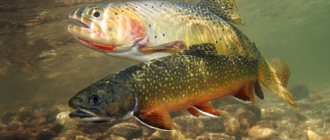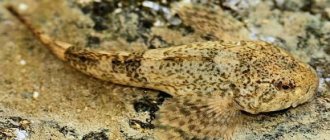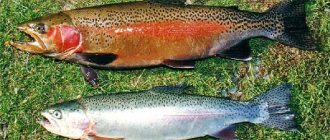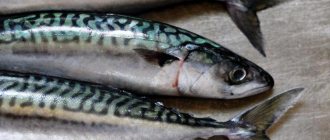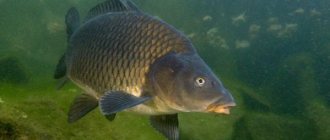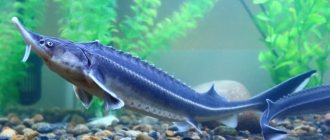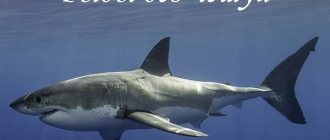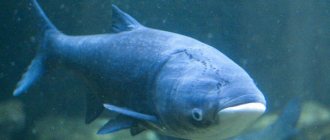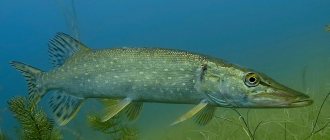This type of trout lives only in the legendary Lake Sevan and small lakes located nearby.
It has another name, which is translated from Armenian as “King”. The fish grows to a meter in length, gaining weight up to fifteen kilograms. These figures are significantly higher than those of the European species of this fish. And the color of this type of trout is more colorful. Unlike its European counterpart, Sevan trout is covered with larger and brighter spots, there are not so many of them. But they make it decorative. What fish do you most often make sandwiches with?
- With trout 27%, 102 votes
102 votes 27%102 votes - 27% of all votes
- With salmon 24%, 89 votes
89 votes 24%
89 votes - 24% of all votes
- With sprats 19%, 72 votes
72 votes 19%
72 votes - 19% of all votes
- With salmon 13%, 50 votes
50 votes 13%
50 votes - 13% of all votes
- With herring 9%, 33 votes
33 votes 9%
33 votes - 9% of all votes
- Other 7%, 26 votes
26 votes 7%
26 votes - 7% of all votes
Total votes: 372
16.10.2019
×
You or from your IP have already voted.
Trout in this area comes in four subspecies, which differ from each other:
- winter ishkhan
- summer ishkhan
- Gegharkuni
- Bojack.
And each of these types has its own characteristics.
Varieties
Trout from Lake Sevan belongs to a special species and is very different from other representatives of this species. Unlike other trout species, whose weight rarely exceeds the seven-kilogram mark, the Sevan species can reach a weight of more than 15 kg and have a length of about a meter.
Ishkhan differs from European trout not only in its greater weight, but also in appearance. If the color of European trout includes many small spots, then the Sevan species has very few such spots, and they are much larger. Ichthyologists distinguish 4 subspecies of ishkhan, which have a number of significant differences among themselves.
WINTER ISHKHAN
The largest subspecies of Sevan trout is called “winter ishkhan”. Its maximum weight can be close to 20 kg, and its length can be more than a meter. This fish is silver in color with a small number of large, dark spots. Interestingly, the spots can have a variety of shapes. Each spot has a light edge.
Interesting! Despite such impressive size, the winter iskhan is not a pronounced predator and feeds mainly on bottom crustaceans.
Fish of this subspecies reach maturity at the age of 5 years. During the spawning period, males radically change their color. Their scales take on a dark tint, and the few spots on their sides become bright red. Females do not change their appearance during spawning. The spawning grounds of the winter Ishkhan are the shallow bays of Lake Sevan. At one time, the female is capable of laying more than 4,000 eggs.
It should be noted that the lake is home to 2 herds of winter Ishkhan, which spawn at different times and at different depths. The spawning of the first herd lasts from October to January, while the fish spawns at a depth of up to 4 m. The spawning of the second herd takes place from January to March, and the eggs are deposited at a depth of up to 20 m. In recent years, the reservoir has become very shallow, which has led to the loss of many spawning grounds winter ishkhan. Due to this circumstance, the number of this subspecies has sharply decreased.
Trout
Product Description
Trout is a fish of the species Salmo trutta morpha lacustris, which lives in cold lakes with clean, clear water and spawns in fast, rapids rivers flowing into the lakes. It is found in the north-west of our country, in Finland, Sweden and Norway, in the cold lakes of the Alps, in the Balkans and in Transcaucasia. As a rule, lake trout are smaller than migratory trout, although sometimes, for example, in Lake Ladoga, its weight can reach 8–10 kg.
Recipes for cooking trout are found in cookbooks of medieval monasteries. This fish was very highly valued for its excellent taste; rich nobles and priests gladly accepted it as a gift, especially during Lent. In the 19th century, a Pacific trout species was brought from America to Europe - rainbow trout, which was perfect for artificial breeding due to its unpretentiousness and rapid weight gain. Now the main producers of cage trout are Norway, Scotland and Ireland.
Trout meat is rich in omega-3 fatty acids, as well as fat-soluble vitamins A and D. In addition, fish contains a lot of water-soluble vitamin B12.
Types and varieties
A small part of trout does not grow in large bodies of water, but in rivers and streams, down to the smallest ones, turning into brook or common trout (Salmo trutta morpha fario) - a medium-sized fish (usually 25–35 cm in length and 200–500 g in weight, extremely rarely up to 2 kg), very brightly colored on the outside and completely white on the inside. The back of brook trout is dark, the belly is white or golden-yellow, small spots are scattered on the sides and fins - black, orange and red, often surrounded by a light rim (the color of brook trout largely depends on the color of the water and the soil of the reservoirs). The favorite habitat of this fish is clean mountain rivers with cold water. River trout can be found throughout Europe, and sometimes in Asia Minor.
Freshwater rainbow trout be native to the West Coast of North America, from where they were introduced to Europe in the 19th century. It grows quickly and is very suitable for breeding. The body length usually reaches 70 cm. Numerous small black spots in the form of dashes and dots are scattered throughout the body, especially below the lateral line. In adults, a noticeable iridescent-crimson stripe runs along the body. However, the color of fish can vary depending on their habitat.
In the Armenian mountain lake Sevan they catch the famous Sevan trout , which is famous for its delicious fatty pink meat.
lake trout is caught in the cool waters of the Kola Peninsula, in Lakes Ladoga and Onega. These fish weigh on average from 1 to 10 kg. On the back of lake trout, the spots are shaped like the letter X.
Sea trout (silver salmon) is an anadromous fish that lives for a year in fresh water and then moves to river mouths where the water is brackish for two to three years. The length of this fish reaches a meter.
How to cook
Trout has tender and very tasty meat with thick skin without intermuscular bones. It lends itself perfectly to various types of culinary processing; it can be grilled, steamed, baked, fried, it goes well with various side dishes, and is suitable for smoking and pickling.
You can cook excellent fish soup from trout caught in the wild. And its fairly high fat content makes it an excellent filling for pies and dumplings.
Trout is used in almost all cuisines of the Northern Hemisphere. In Chinese cuisine it is cooked in sweet and sour sauce, in Japanese it is used for sushi, sashimi, and teriyaki kebabs. In Malaysia they cook a spicy hot soup called laksa. In Finland they love milk soup with trout, in Norway trout is baked in large pieces and served with potatoes and cucumber salad, Sweden is famous for its sea trout gravlax (salted with dill and aquavit), and in Denmark all kinds of sandwiches are prepared with trout on all types of local bread . In France, trout is poached in champagne, and in the USA they serve bagels (mini bagels) with smoked trout. In Armenia, many wonderful dishes are prepared from Sevan trout, poached with garlic and red pepper, stuffed with rice and raisins. It is used to make soup with dogwood, steamed with tarragon, and served with nut sauce.
How to select and store
Deep dents on carcasses are a reliable indicator of good quality. They are formed when fresh and sometimes live fish on board a trawler enters a freezer form: the carcasses are pressed into each other and freeze. If you see such dents, it means that the fish has never been defrosted before meeting you: after defrosting, all the dents will straighten out, and the seller will not be able to recreate them.
Summer Ishkhan
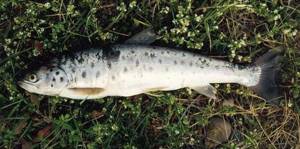
The second species of Sevan trout is the summer ishkhan. This fish is also called summer bahtak. They called it that because it lays eggs in spring or summer. Its spawning takes place in the Bakhtak-chay and Gedak-bulakh rivers, as well as in Sevan itself, in the pre-estuary areas of the lake. This type of trout is smaller. Its maximum weight reaches two kilograms, and its length is about 60 centimeters. Summer ishkhan matures at the age of 2-7 years. This type is a less prolific trout species.
GEGHARKUNI
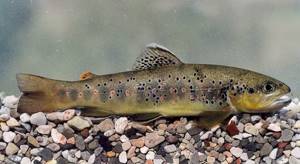
Another type of Sevan trout is called “Gegharkuni”. This subspecies differs from other trout living in Sevan by its original color. On the body of this fish there are not only variegated spots, but also transverse stripes, uncharacteristic of salmon. In general, the color of Gegharkuni is slightly darker than that of other Sevan trout, but it also has a silvery tint.
The main difference between Gegharkuni and other salmonids of Lake Sevan is that this subspecies feeds not only on bottom crustaceans, but also on zooplankton, which is brought into the lake by river flows. In addition, unlike its closest relatives, gegharkuni can spawn only in the running water of rivers flowing into the lake.
Important! Despite all attempts to restore the number of Sevan trout, its population is declining every year. The reason for this is the natural decrease in the water level in the lake and the reduction of natural spawning grounds.
In the 90s, a sharp increase in biogenic elements in the water was noted in Lake Sevan, which could enter the reservoir through industrial and municipal wastewater. After the water was polluted, the lake began to become heavily overgrown, which also negatively affected its underwater inhabitants.
Today Sevan trout is on the verge of extinction. Several years ago, this species was listed in the Red Book, so any fishing for Ishkhan is strictly prohibited.
BOJACK

The smallest subspecies of ishkhan is bojak. Ichthyologists claim that the maximum size of this dwarf trout is limited to 30 cm. Fishermen's catches usually contain fish 15–20 cm long. Males of bojak are characterized by red spots on their sides. It spawns only in lakes and enters rivers extremely rarely. Bojack becomes sexually mature at the age of 4 years.
An interesting fact is that, unlike its closest relatives, this subspecies does not make nests for laying eggs. Bojack spawns throughout the bottom soil of the lake, at a depth of more than 30 m.
Excerpt characterizing Ishkhan (fish)
Count Ilya Andreich lowered his eyes when he heard these words from his son and hurried, looking for something. “Yes, yes,” he said, “it’s difficult, I’m afraid, it’s difficult to get... never happened to anyone!” yes, who hasn’t happened to... - And the count glanced briefly into his son’s face and walked out of the room... Nikolai was preparing to fight back, but he never expected this. - Daddy! pa... hemp! - he shouted after him, sobbing; excuse me! “And, grabbing his father’s hand, he pressed his lips to it and began to cry. While the father was explaining to his son, an equally important explanation was taking place between the mother and daughter. Natasha ran to her mother excitedly. - Mom!... Mom!... he did it to me... - What did he do? - I did, I proposed. Mother! Mother! - she shouted. The Countess could not believe her ears. Denisov proposed. To whom? This tiny girl Natasha, who had recently been playing with dolls and was now taking lessons. - Natasha, that’s complete nonsense! – she said, still hoping that it was a joke. - Well, that's nonsense! “I’m telling you the truth,” Natasha said angrily. – I came to ask what to do, and you tell me: “nonsense”... The Countess shrugged. “If it’s true that Monsieur Denisov proposed to you, then tell him that he’s a fool, that’s all.” “No, he’s not a fool,” Natasha said offendedly and seriously. - Well, what do you want? You are all in love these days. Well, you’re in love, so marry him! – the countess said, laughing angrily. - With God blessing! - No, mom, I’m not in love with him, I must not be in love with him. - Well, tell him so. - Mom, are you angry? You’re not angry, my dear, what’s my fault? - No, what about it, my friend? If you want, I’ll go and tell him,” said the countess, smiling. - No, I’ll do it myself, just teach me. Everything is easy for you,” she added, responding to her smile. - If only you could see how he told me this! After all, I know that he didn’t mean to say this, but he said it by accident. - Well, you still have to refuse. - No, don't. I feel so sorry for him! He is so cute. - Well, then accept the offer. “And then it’s time to get married,” the mother said angrily and mockingly. - No, mom, I feel so sorry for him. I don't know how I'll say it. “You don’t have anything to say, I’ll say it myself,” said the countess, indignant that they dared to look at this little Natasha as if she were big. “No, no way, I myself, and you listen at the door,” and Natasha ran through the living room into the hall, where Denisov was sitting on the same chair, by the clavichord, covering his face with his hands. He jumped up at the sound of her light steps. “Natalie,” he said, approaching her with quick steps, “decide my fate.” It's in your hands! - Vasily Dmitrich, I feel so sorry for you!... No, but you are so nice... but don’t... this... otherwise I will always love you. Denisov bent over her hand, and she heard strange sounds, incomprehensible to her. She kissed his black, matted, curly head. At this time, the hasty noise of the countess's dress was heard. She approached them. “Vasily Dmitrich, I thank you for the honor,” said the countess in an embarrassed voice, but which seemed stern to Denisov, “but my daughter is so young, and I thought that you, as a friend of my son, would turn to me first.” In this case, you would not put me in the need of refusal. “Gafinya,” Denisov said with downcast eyes and a guilty look, he wanted to say something else and faltered. Natasha could not calmly see him so pitiful. She began to sob loudly. “Countess, I am guilty before you,” Denisov continued in a broken voice, “but know that I adore your daughter and your entire family so much that I would give two lives...” He looked at the countess and, noticing her stern face... “Well, farewell, lady,” he said, kissed her hand and, without looking at Natasha, walked out of the room with quick, decisive steps. The next day, Rostov saw off Denisov, who did not want to stay in Moscow for another day. Denisov was seen off at the gypsies by all his Moscow friends, and he did not remember how they put him in the sleigh and how they took him to the first three stations. After Denisov’s departure, Rostov, waiting for the money that the old count could not suddenly collect, spent another two weeks in Moscow, without leaving the house, and mainly in the young ladies’ room. Sonya was more tender and devoted to him than before. She seemed to want to show him that his loss was a feat for which she now loves him even more; but Nikolai now considered himself unworthy of her. He filled the girls' albums with poems and notes, and without saying goodbye to any of his acquaintances, finally sending all 43 thousand and receiving Dolokhov's signature, he left at the end of November to catch up with the regiment, which was already in Poland. After his explanation with his wife, Pierre went to St. Petersburg. In Torzhok there were no horses at the station, or the caretaker did not want them. Pierre had to wait. Without undressing, he lay down on a leather sofa in front of a round table, put his big feet in warm boots on this table and thought. – Will you order the suitcases to be brought in? Make the bed, would you like some tea? – asked the valet. Pierre did not answer because he did not hear or see anything. He began to think at the last station and continued to think about the same thing - about something so important that he did not pay any attention to what was happening around him. Not only was he not interested in the fact that he would arrive in St. Petersburg later or earlier, or whether he would or would not have a place to rest at this station, but it was still in comparison with the thoughts that occupied him now whether he would stay for a few days. hours or a lifetime at this station. The caretaker, the caretaker, the valet, the woman with Torzhkov sewing came into the room, offering their services. Pierre, without changing his position with his legs raised, looked at them through his glasses, and did not understand what they could need and how they could all live without resolving the questions that occupied him. And he was preoccupied with the same questions from the very day he returned from Sokolniki after the duel and spent the first, painful, sleepless night; only now, in the solitude of the journey, did they take possession of him with special power. No matter what he started to think about, he returned to the same questions that he could not solve, and could not stop asking himself. It was as if the main screw on which his whole life was held had turned in his head. The screw did not go in further, did not go out, but spun, not grabbing anything, still on the same groove, and it was impossible to stop turning it.
Map - Areas
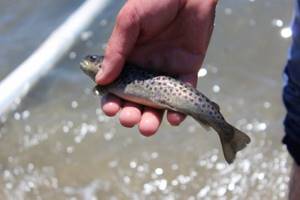
- Sevan trout Salmo ischchan,
- Black Sea salmon Salmo trutta labrax,
- Caspian salmon Salmo trutta caspius,
- Aral salmon Salmo trutta aralensis
The main factors that caused a sharp decrease in the number of all races of Sevan trout should be considered a violation of reproduction conditions as a result of a decrease in the level of Lake Sevan by 18.5 m and drainage of spawning grounds, deterioration of habitat conditions for juveniles in rivers, and a reduction in the scale of artificial breeding. The decline in numbers was also adversely affected by eutrophication of the lake, poaching, especially during the breeding season, and the complete lack of protection of trout.
Sevan trout (cooking)
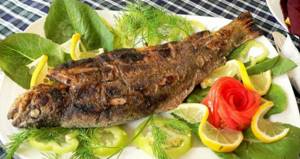
Cooking Sevan trout at home. This simplified recipe will allow you to prepare the dish in a hurry. Tasty, simple, healthy. Be sure to try it!
Description of preparation
Sevan trout is a dish of national Armenian cuisine, which, if you have the skill, can be prepared in less than an hour. This recipe for preparing Sevan trout differs from others mainly in the use of ginger and a small amount of other types of spices.
- Trout – 800 grams
- Lemon – 1 piece
- Onions – 1 piece
- Grated ginger - 1/2 tbsp. spoons
- Garlic – 1 clove
- Tomato – 1 piece
- Soy sauce - 1 tbsp. spoon
- Greens - To taste
- Olive oil - 2 tbsp. spoons
- Salt - To taste
- Pepper - To taste
Number of servings: 3-4
Video
Sevan (Armenian) trout - description of the species with photos
This type of trout lives only in the legendary Lake Sevan and small lakes located nearby. It has another name, which is translated from Armenian as “King”. The fish grows to a meter in length, gaining weight up to fifteen kilograms. These figures are significantly higher than those of the European species of this fish. And the color of this type of trout is more colorful. Unlike its European counterpart, Sevan trout is covered with larger and brighter spots, there are not so many of them. But they make it decorative.
Trout in this area comes in four subspecies, which differ from each other:
- winter ishkhan
- summer ishkhan
- Gegharkuni
- Bojack.
And each of these types has its own characteristics.
Salmonidae

The body of salmon fish is covered with scales that fit tightly to the skin.
There are no scales on the head. A characteristic feature of this family of fish is the presence of a second dorsal fin of a special structure - adipose, which is located on the back at the beginning of the caudal peduncle. Salmon meat is tender and lacks intermuscular bones. Almost all fish of this family (except whitefish, whitefish, nelma, vendace) have red meat of various shades. The large salmon family includes large fish such as salmon and small fish such as vendace. But all salmon are characterized by high taste quality of meat, and most have significant fat content. The fat content of some salmon reaches up to 27%. These fish accumulate large amounts of fat between the muscles, in the walls of the abdomen (teshka), under the skin and in the abdominal cavity. Large salmon - Caspian, Far Eastern, as well as salmon and nelma are received by public catering establishments salted or fresh frozen; Far Eastern salmon also comes in the form of natural canned food. During the process of very moderate salting, the fatty, tender meat of large salmon is saturated with fat, acquires a specific taste (“ripens”) and becomes one of the best gastronomic products. Cooks use lightly salted salmon meat to prepare cold appetizers, salads, etc. These fish products are not cooked. Frozen salmon meat is best boiled or fried on a grill. Among the fish of the salmon family, trade enterprises most often obtain fresh, chilled or frozen whitefish, trout, and vendace. Salmon. This fish is one of the best in our waterways. It often reaches 40 kg in weight and 150 cm in length. It has a lot of fat (from 11 to 24%). The best salmon, the largest and fattest, is caught in the Northern Dvina; A lot of salmon are caught in the Pechora River. This salmon is widely known as Dvinskaya and Pechora salmon. Salmon cut into thin slices is served as an appetizer; It is used to prepare open sandwiches, sandwiches (closed sandwiches), canapés (curly small sandwiches), it is added to salads, and it is used to decorate cold fish dishes. Caspian salmon. The best salmon is Kurinsky. It is caught in autumn and winter in the Kura River. Winter catch fish contains up to 27% fat. Large specimens are up to 1 m long and weigh 40-50 kg. Middle Caspian salmon (Caspian or Kizlyar) are smaller and somewhat less fatty; they have very tender, tasty meat, on the cuts of which droplets of transparent fat appear. Trout. This very beautiful fish has several varieties: speckled trout, Sevan trout, rainbow trout, lake trout, etc. Trout is one of the most delicious fish in our water basins. It is caught in natural bodies of water (lakes, rivers, streams), and is also specially bred in ponds. Cooks prepare delicious fish dishes from it; it is good boiled and fried. The property of trout (as well as some other fish, such as carp) is to acquire a beautiful blue color from vinegar in the first hours after stunning - culinary specialists use it in the preparation of a tasty and beautiful dish “blue trout”. Belorybitsa. This rare fish is found only in Russia and Kazakhstan; They catch it in the Caspian Sea and in the lower reaches of the Volga. It has a particularly delicate and delicate taste. Almost the entire catch of whitefish is used to prepare balyks and tesh. Whitefish fat in large quantities (18-26%) is deposited in the tissues of the abdomen and back. Nelma. In terms of the taste of its white tender meat, nelma is close to white fish and is also one of the best fish of the salmon family. Despite the fact that nelma is inferior in fat content and size to whitefish, nelma balyks are also of very good quality. Cooks prepare a variety of dishes from fresh or frozen nelma, with fried nelma being the most delicious. Taimen. Large specimens of this fish reach 1 m in length and 65 kg in weight. Taimen meat is very tasty, although less fatty than salmon meat. Brown trout. The taste of brown trout meat resembles the taste of salmon, despite the fact that its meat is coarser and less fatty. Almost the entire catch of this fish goes to the ambassador.
FAR EASTERN SALMON
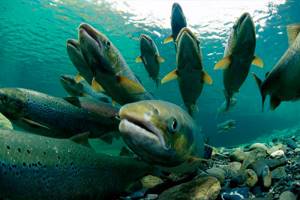
SIGI
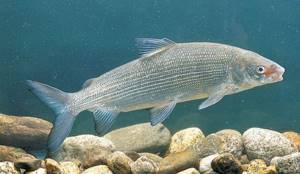
Smelt
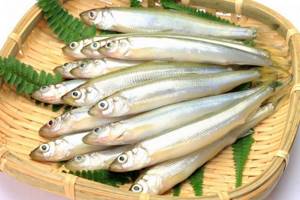
Summer Ishkhan
This subspecies of trout differs from the winter ishkhan in appearance and timing of spawning. Already from the name it is clear that the summer Ishkhan spawns strictly in the summer. The summer Ishkhan reaches a length of 60 centimeters and weighs about 2 kg. The appearance of these subspecies is also significantly different. This type of fish is not only smaller, but the spots on its body are blurry, irregular in shape, and dark in color.
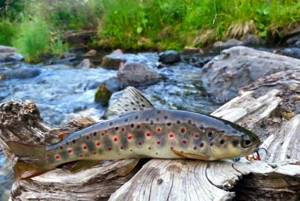
What does trout look like?
Depending on the species and habitat, trout looks different and there are many differences. But there are also general similarities in the description of trout. Typically, the body of trout fish is dense and voluminous, the nose looks as if it is blunt, but in large males, with a more elongated snout and a brighter body color, a small cartilaginous hook grows at the tip of the lower jaw. The paired fins of trout are rounded, the scales always have a round shape.
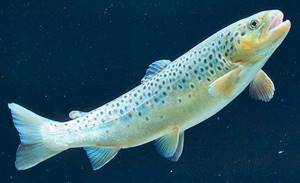
The trout's back is mostly brown or brownish-green, the sides of the fish's body are light, silver, yellow or yellowish, and the fins are yellowish-gray. Red spots on the body of a trout are usually located along the lateral line or on its sides and may have a blue border. It happens that the trout looks without obvious spots on the body, there are no red and no black spots, but only small specks remain. The dorsal fin of the fish is usually dotted with black and red spots. There is an adipose fin on the back between the dorsal and caudal fins.
The color of trout varies depending on its habitat, the color of the water and environment, the food and the time of year. Obviously, in calcareous water, the body of a trout always looks lighter and silverier, and in rivers flowing along a peaty or muddy bottom, trout are very dark in color.
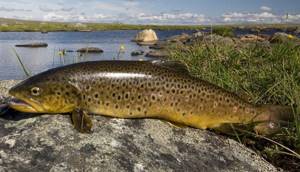
It is known that trout that feed on insects have reddish fins and more red spots, and trout that feed on small fish have more black spots. It is also believed that the more well-fed the trout, the more uniform its body is, the spots are less pronounced, the back is thicker, the head is smaller, and the meat becomes more yellow or redder. It is also known about this fish that the less oxygen in the water, the redder the trout’s meat.
Male trout differ from females in the relative size of their heads and the larger number of teeth; in some older males, the tip of the lower jaw curves upward, like a salmon. And like many fish, female trout are always comparatively larger than males.
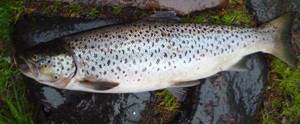
The size of trout depends on its habitat and species; usually it does not reach the size of salmon and taimen. River or brook trout in rivers and streams reaches a size of no more than 20-40 cm. Lake and sea trout reach significant sizes, and under very favorable conditions grow up to one meter long and weigh up to 12 kg. The size of a trout depends on the abundance of food in a given water area, and with an abundance of food, trout grows very quickly.
Gegharkuni
This subspecies of Sevan trout is perhaps the most beautiful in color. Not only are the spots on his body more frequent, they are also different in color. In addition to the spots, there are also stripes along the entire body, and the body color itself is a more saturated shade of bronze with silver tints.
In addition to its colorful colors, gegharkuni differs from others in that it spawns only in those places of lakes where rivers flow into. Caviar needs air and water movement for better development.

bojack
This subspecies of trout, unlike all other representatives of this fish in the lake, is quite small. It does not grow more than 30 centimeters. And the bojack spawns, without making nests, at the depth of the entire lake. Simply sowing eggs on the bottom surface in its habitat.
The most interesting thing is that each of the species has chosen its own habitat in the lake and does not pose a threat to each other at all, despite the fact that they are predatory fish. They do not interfere with the reproduction and hatching of young animals, because they differ in habitat and spawning time. All species of Sevan trout are on the verge of extinction due to environmental pollution, overgrowing of lakes, and poaching.
Armenian trout, as this type of fish is also called, is very popular among local residents and not only among them. To visit Armenia and not try dishes made from this fish will be considered almost a crime, an act of disrespect for the entire people. This is why poaching in Lake Sevan flourishes, and no measures are taken to protect and breed this fish.
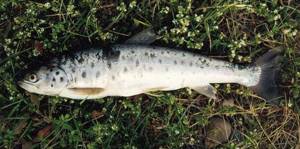
Everything about Armenia
Tareh

Tareh (Տարեխ) is the only fish that is found in the salt water of Lake Van (Western Armenia). It belongs to the carp family, but looks more like a herring. Tarekh fish can live in both fresh and salt water, where the percentage of salinity reaches 23%. Today in Turkey, fishing for this fish is prohibited due to its small quantity. As for dishes made from it, tareh is most often salted, smoked and served as an appetizer with pickles and vegetables.
Carp

Carp (Սազան) is a fairly large freshwater fish that lives in Lake Arpi (the second largest fishable lake in Armenia). Previously, carp was the main fish found in the lake. But over time, the number of inhabitants increased: chub, asp, khramulya, trout, bystryanka and others. The main advantage of carp is its juicy flesh and a small number of bones. Therefore, dishes prepared from it are not just tasty, but also appetizing.
Ishkhan

Ishkhan - (Armenian prince-fish, Իշխան) - belongs to a species of the salmon family and lives in Lake Sevan. In Armenia it is also called: bakhtak, gegharkuni, bojak and Sevan trout. Note that in the Soviet years, Ishkhan was considered the largest fish, reaching from 90 to 104 cm. And in the early 1930s, it was artificially relocated to the salt lake Issyk-Kul (Kyrgyzstan). There the ishkhan was able to take root and compete with other species. Currently, Ishkhan is included in the Red Book of Armenia under category I.
Carmrahite

Karmrahit - (Կարմրախայտ), also known as mountain brook trout, is found in the upper reaches of the Armenian mountain rivers Azat, Hrazdan, Vorotan, Mis-khana and Debet. Karmrahite got its name because of its red and black spots, which makes its appearance very unusual and memorable. The peculiarity of the fish is that it is very quick and has a special, dietary taste. Dishes prepared from karmrahite are considered the most delicious.
Whitefish

Whitefish (Սիգ) is the main commercial fish species in Lake Sevan; in the 20-30s of the last century it was brought from Lake Ladoga (Russia). During the Soviet Union, due to electricity generation, disruption of the local ecosystem and poaching, Sevan's fish resources declined sharply. Then the aquatic inhabitants of the lake acclimatized, negatively affecting the entire fauna. Today, everything has changed and the whitefish catch accounts for 80% of the total fishery in Sevan. As for its taste, whitefish has exceptionally juicy meat: it is baked, boiled with herbs, fried, smoked and stewed in various sauces.
Ishkhan fish photo
Ishkhan - king fish from Armenia
Products - tags: ishkhan, gegharkuni, bojak, summer bakhtak, alabalakh
While setting up a continuation of the topic on ecology, I came across a conversation about Lake Sevan. Well, how can we not remember the famous fish, which is found only in Armenia, and which is called ISHKHAN? In the Baltics, trout is a fairly common product. And oddly enough, it is not that expensive. But trout (and ishkhan is a type of trout) is said to be superior in taste to Baltic trout. Well, maybe it’s Armenian nationalism that pushes us to think so)))
And yet a little about fish, which is considered a delicacy.
Ishkhan is a fish, otherwise called Sevan trout. “Ishkhan” translated from Armenian means “prince,” and indeed, this fish that lives in Lake Sevan is completely different from the usual trout that swims in all the rivers of Europe. Thus, Ishkhan is a lake fish, and it is represented in several species that spawn at different times of the year. Sevan trout comes to grocery stores from Armenia both fresh and frozen. Ishkhan is a fish ideal for all types of culinary processing. Containing the perfect amount of protein and fat, it is especially good served with white sauce and accompanied by roasted vegetables. Ishkhan is a fish that goes well with seasonings unusual for its counterparts: fruits, nuts, pomegranate and lemon juice.
There is a wide range of dishes based on ishkhan: fish can be boiled, fried in wine, stewed with almonds, and so on. Ishkhan is a fairly large fish, which is highly valued in the Armenian food market and is therefore the object of significant fishing. Since Lake Sevan, where Ishkhan is found, is located on the territory of Armenia, dishes made from Sevan trout are typical of Armenian cuisine. A very popular delicacy is ishkhan in wine with the addition of basil, tarragon, green onions and pepper. To prepare it, you first need to prepare the ishkhan: the fish is removed from the entrails and washed well. Then sticks are placed on the bottom of the stewpan, on which the fish, already treated with salt and pepper, is placed. Next, you need to give the Armenian taste and aroma to the ishkhan: for this purpose, the fish is covered with tarragon and other herbs.
After forming a dish of two layers of fish, sprinkled with lemon juice and covered with herbs, a glass of dry white wine is poured into a saucepan and put on fire. It is easy to determine the readiness of ishkhan - the fish should easily separate from the skin when touched with a wooden spatula. It’s even easier to prepare boiled ishkhan: the fish is washed, salted, sprinkled with lemon juice and placed in an oblong flat dish, where vinegar, water and onion are added. In 8-9 minutes the fish will be ready
Armenian sauce for Ishkhan
Served with various sauces. The most popular sauce in Armenia using walnuts. For this, the walnut kernels are peeled and poured with boiling water so that the brown skin comes off. Then pound in a mortar along with fresh cilantro or coriander seeds. Then add a glass of water and cook over low heat for 10 minutes, adding salt and sugar to taste. A few minutes before the end of cooking, add wine vinegar or lemon juice.
There are a huge variety of sauce recipes for this fish. Probably, as many housewives in Armenia as there are so many recipes. Even the photo shows how each dish, with basically the same ingredients, can differ from one another. Although each will be based on the same trout.
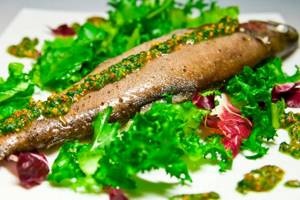
Any local family strictly keeps its secrets and traditions of preparing this national dish. Trout is a source of pride for the entire people, just like the majestic Lake Sevan itself. Therefore, it is necessary to protect and appreciate what nature provides.
Subspecies
Ishkhan forms 4 subspecies (sometimes a 5th one, alabalakh, is mistakenly attributed to it) differing in time and place of spawning, as well as growth rate: winter bakhtak and bojak are lake fish, summer bakhtak and gegharkuni are migratory fish. Ishkhan is the largest trout found in the USSR: winter melon reaches 90 cm (there have been cases of catching winter melon up to 104 cm long), weighs up to 17 kg. The subspecies mainly feed on bottom-dwelling amphipods. Ishkhan is the main commercial fish of Lake Sevan. The catches are dominated by fish aged 4-6 years (28-33 cm long, weighing 340-560 g). [1]
Winter melon (Salmo danilewskii)
Winter melon is the largest representative of the Sevan trout species. There are from 104 to 119 scales in the lateral line, 16-20 gill rakers. At the age of 4-5 years, the winter melon matures.
During feeding, the bahtak is silvery-white with a dark, steel-colored back. Few dark spots are surrounded by a light rim. Males darken before spawning, their fins become almost black, the light rim on the black spots stands out very sharply, and 2-3 red spots appear on the sides of the body. The females change little and lay eggs in the lake itself (about 4 thousand eggs).
After the fall in the level of Sevan, almost all the main spawning grounds of winter melon found themselves on the shore. Now it is found very rarely, mainly in areas of preserved spawning grounds. Before the decrease in the water level of Sevan, the commercial stock of winter fish was about 1.5 million individuals.
Gegharkuni (Salmo ischchan gegarkuni)
Gegharkuni is an anadromous form of Sevan trout. The body of the juveniles has dark transverse stripes and brown-yellow and red spots. Individuals older than one year feed in the lake. The coloring is similar to that of the winter Ishkhan, but seems somewhat darker due to larger and more frequently spaced spots; individuals weighing up to 16 kg are found. Gegharkuni feeds not only on benthos, like its relatives, but also on zooplankton. Gegharkuni breeds exclusively in rivers, at their sources.
Before the water level of Sevan dropped, the commercial stock of Gegharkuni was about 1.6 million individuals.
Summer melon (Salmo ischchan aestivalis)
Summer melon lays eggs in spring and summer in rivers flowing into the lake and in the lake itself, in the areas near the mouth. The size of the summer melon reaches up to 55 cm in length, weight - 1.9 kg, the number of scales in the lateral line is 105-117.
The fish matures at the age of 2 to 7 years, it is less prolific than the winter melon: it lays an average of 1200 eggs on the ground of gravel and pebbles. The summer Ishkhan often has red spots on the sides of its body. Until the mid-1940s, the commercial stock of this form was estimated at 1.7 million individuals, by the 60s - at 0.8 million individuals, at present it is equal to several thousand individuals.
Bojack (Salmo ischchan danilewskii)
Bojak is the smallest representative of the Sevan trout: its body length does not exceed 33 cm, weight 224 g. The average length of these fish is 24-26 cm. Bojack males, especially small ones, often have red spots on their sides. Bojack spawns only in the lake, at 3-4 years of age. Unlike other subspecies of ishkhan, bojak builds nests and scatters its eggs along the bottom of the lake, at depths from 0.5 to 15 m in October - November at a temperature of 10°C. [2] [3]
The main distinctive features of the bojack are a large eye, a short snout, a narrow forehead, short bases of the dorsal and anal fins, and a smaller number of gill rakers compared to other races (15-20). Bojack is never artificially reproduced. Before the decrease in the water level of Sevan, the commercial stock of winter fish was about 1.5 million individuals. [4]
What kind of fish, description, where it is found
The benefits of this fish depend on how properly it is cooked. The product has a positive effect on the body, but it is important to take into account the daily consumption rates and contraindications.
Kahawai has several names, including "Big Arrip" or "Australian Salmon". The fish belongs to the order Perciformes. Kahawai is similar to salmon only in appearance. The very name “kahawai” was borrowed from the people of New Zealand.
According to the size, the fish can reach 50 centimeters. Its average weight is 5-7 kilograms. However, there are individuals weighing more than 10 kilograms. The body shape of the fish is slightly rounded, reminiscent of a spindle.
The scales are silvery-white below and dark on the back. Australian salmon have a dark blue or green dorsal fin.
This fish is widespread in the southwestern part of the Pacific Ocean; it is also found in the waters of New Zealand, Tasmania and Australia. This fish feeds mainly on squid, anchovies, horse mackerel, mackerel or other small fish.
It is recommended to consume no more than 100 grams. per day
